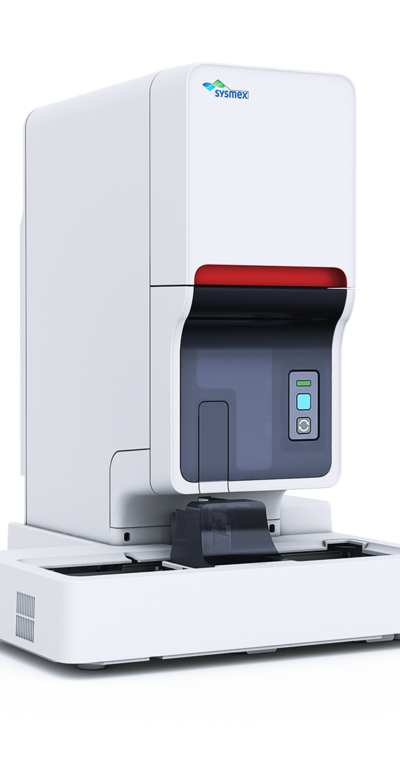Malaria? Be confident.
Malaria, for some, may present as a faraway tropical disease, but for others is indeed an everyday challenge. Travelling and migration though have brought malaria to the doorsteps of virtually every country on the planet. Sysmex, identifying this threat and building on its haematology expertise, can help you identify malaria-infected red blood cells with confidence, guiding treatment decisions and evaluating treatment success, no matter whether you are dealing with malaria on an everyday basis, or you occasionally meet travellers suspected of an infection.
On this page you can
- explore the benefits from Sysmex’s solution to aid malaria diagnosis, the XN-31 analyser,
- see XN-31 in action using real-life examples and
- read about the recommended diagnostic guidelines from the World Health Organisation (WHO) and other medical associations all over the world.
“XN-31 analyser provides a rapid, objective, sensitive and accurate assessment of the presence of malaria parasites. Quantitative values of parasitaemia are provided, which enable monitoring of parasite clearance and treatment success. These parameters may also provide an early indication of anti-malaria drug resistance.”
Benefits
- Sensitive detection and count of malaria-infected red blood cells (MI-RBC) within just one minute.
- All information relevant to treatment decision in one analysis: accurate enumeration of malaria-infected red blood cells and detection of all Plasmodium species capable of infecting human red blood cells.
- A concurrent complete blood count assists in determining other clinical conditions, such as anaemia.
- Reliable results provided by a fully automated, standardised analysis.
Simultaneous accurate enumeration and direct detection of malaria-infected red blood cells and anaemia in a paediatric sample
An infant under the age of one year was examined in a hospital of the malaria endemic country Burkina Faso. Blood analysis on the XN-31 analyser identified a high load of malaria-infected red blood cells (MI-RBC = 68.09 x 103 cells/μL) in combination with the presence of mostly ring forms, thus a diagnosis of malaria, probably caused by Plasmodium falciparum, was made. Further information from the complete blood count on the same analyser revealed the presence of microcytic hypochromic anaemia (MCV = 50.9 fL, MCHC = 25.9 g/dL and HGB = 5.6 g/dL). Based on these findings, a severe malaria was diagnosed, and a single intravenous treatment with 45 mg artesunate was initiated, as recommended by the WHO. A follow-up two days later revealed the successful course of the treatment with a significant reduction in the parasitaemia load (MI-RBC = 0.21 x 103 cells/μL).
A fast and reliable direct detection of malaria-infected red blood cells and concomitant anaemia was conducted using a single analyser that can be operated without the extensive training a malaria microscopist would need. Detailed red blood cell indices showed that a severe malaria could be underway, thus a specialised treatment was immediately initiated, which proved to be successful. Distinguishing between a severe and an uncomplicated malaria is important for choosing the correct therapeutic regimen. An uncomplicated malaria, as the WHO guidelines state (see tab ‘External resources’), is treated differently from a severe malaria case described above. One of the recommended artemisin-based combination therapies for uncomplicated malaria is given orally for three days, in order to clear the parasites from the blood as soon as possible and prevent its progression to a severe case.
Fast and confident treatment monitoring in an adult traveller
A 45-year-old male, permanent resident of a malaria non-endemic European country, visited Tanzania for a two-week holiday. Three days after returning to his home country, he started to have fever, shivers and a headache. Five days later, when symptoms had worsened and by then also included myalgia, arthralgia and malaise, he visited the local hospital. When the patient presented at the emergency department, he had a fever of 39°C, weakness and reduced awareness. As the patient was severely ill and had recently returned from a tropical area, malaria was suspected. Hence, the treating physician ordered malaria examination and a panel of other laboratory examinations (see table below).
A rapid diagnostic test (RDT) demonstrated the presence of HRP-2, an antigen specific for Plasmodium falciparum. Detailed blood analysis on the XN-31 analyser revealed an ongoing malaria infection, probably caused by P. falciparum, with a very high number of malaria-infected red blood cells (MI-RBC = 539 x 103 cells/μL) and the presence of trophozoites (ring forms) and schizonts. These results demonstrated that the patient suffered from severe malaria, thus he was admitted to the intensive care unit (ICU) and therapy was initiated immediately. As per hospital guidelines, the results were confirmed by a quantitative buffy coat (QBC) and a microscopic examination of thin and thick blood smears.
The patient in this case was initially treated with intravenous artesunate (2.4 mg/kg at 0, 12 and 24 hours after diagnosis), after which treatment was continued with oral administration of an atovaquone/proguanil combination (1dd 1000/400 mg for three days). During the treatment period, parasitaemia was determined regularly with the XN-31 analyser until parasites were cleared. The patient was discharged from the hospital after seven days and subsequently fully recovered.
The presence of an analyser that combines the speed of an RDT with the features of a microscopic examination for direct detection and quantification of malaria-infected red blood cells, while not requiring an expert user, was instrumental for rapidly diagnosing malaria outside office hours and acting fast on treatment initiation. Moreover, the high sensitivity of the analyser in detecting malaria-infected RBC (down to 20 per microlitre of blood) was useful in the follow-up measurements during treatment and provided confidence in deeming the treatment successful.
Table with laboratory examinations upon hospital admission
Clinical condition | Examination | Result |
| Hypoglycaemia | Glucose | 3.9 mmol/L |
| Anaemia | Haemoglobin | 7.3 mmol/L |
| Thrombocytopenia | Platelet count | 16x103 cells/μL |
| Renal dysfunction | Urea Creatinine Glomerular filtration rate | 10.8 mmol/L 115 μmol/L 49 mL/min |
| Disturbed plasma electrolytes | Sodium Potassium Calcium | 131 mmol/L 3.8 mmol/L 2.08 mmol/L |
| Acidosis | Plasma lactate | 5.4 mmol/L |
| Bilirubinaemia | Total plasma bilirubin | 119 μmol/L |
| Organ damage | ALAT ASAT γGT Alkaline phosphatase Lactate dehydrogenase | 164 U/L 174 U/L 168 U/L 101 U/L 1015 U/L |
| Inflammation | C-reactive protein (CRP) | 181 mg/L |
| Haemocytometric profile | White blood cells Monocytes Neutrophils Plasma cells | 12.7% 3.5% 38.1% 4.1% |
International guidelines for the diagnosis of malaria
Medical associations and ministries of health all over the world, in line with the WHO recommendations, consider the microscopic examination of thick and thin blood films as the gold standard for the detection of malaria parasites. A thick blood film is used to detect malaria parasites, and upon positivity, the thin blood film can support the identification of the Plasmodium species.
Developed for a quick identification of malaria parasites in endemic countries where the laboratory workload is very high, rapid diagnostic tests (RDT) can also be used as a parasitological test to confirm the diagnosis, as per the WHO guidelines. RDTs were developed and are mainly used for the detection of suspected P. falciparum infections, but newer generations of tests with pan-specific antigen targets have also been shown to be effective for the non-falciparum malaria species.
Medical guidelines in endemic African countries require the use of microscopy where it is applicable, mainly in well-equipped tertiary health institutions. For primary or secondary care, an RDT can be the first diagnostic tool, but only as an alternative or complementary to microscopy. Species determination and parasite quantification can only be done with microscopic examination.
Medical guidelines in non-endemic countries state that a positive RDT must always be followed up by microscopical examination. UK guidelines, for example, consider RDTs as an initial screen when laboratory expertise is not available, but they should not be considered as a replacement for blood film examinations.
Molecular techniques such as PCR are not part of the WHO guidelines, due to insufficient standardisation and validation, but local guidelines in non-endemic countries reserve a role for PCR for the identification of Plasmodium species in highly specialised reference laboratories.
Guidelines and recommendations
- WHO Guidelines for malaria
- UK malaria treatment guidelines
- Guidelines for malaria case management in Ghana
- Guidelines for the treatment of malaria in Malawi
- Canadian recommendation for the prevention and treatment of malaria
- National policy on malaria diagnosis and treatment in Nigeria
Informative sources
- WHO: World malaria report 2024
- WHO: Malaria in the European region
- Malaria factsheet from the European Centre for Disease Prevention and Control
- Malaria diagnosis in the United States from the Center for Diseases Control
- The laboratory diagnosis of malaria in the UK
- Management of imported malaria in Europe








